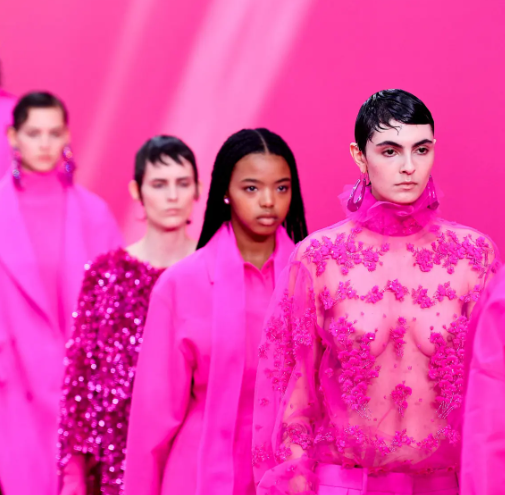Pink Perception! The Psychology Behind Wearing Pink in a Barbiecore Era
Pink
The Psychology Behind our Obsession
It’s an obsession that's impossible to ignore – from the vibrant tones that color our clothes to the muted hues that dominate our social media feeds, pink is a shade that captivates. More than just a fashion trend, pink signifies a shift in societal norms, a fondness for nostalgia, and a deep-rooted psychological connection. So, what's the scientific explanation for our infatuation? And what does our choice to wear pink say about us?
PINK IS MADE UP
In the world of physics, pink is not a color found in the traditional rainbow spectrum. Rather, it's a concoction of hues, primarily a mixture of red and violet light, that our brains interpret as pink. This color blend is not linear, but circular, the red and purple ends of the light spectrum meet to form this hue. It beautifully encapsulates the fiery passion of red and the royal allure of purple. So whilst red can make you feel alert, energetic and aroused, purple brings about cool calm and peaceful feelings. This fusion endows pink with an array of connotations, each evoking different emotions and perceptions. In color psychology, pink is linked with feelings of love, compassion, and optimism.
the psychology behind wearing pink
What you wear impacts how others perceive you. So, what does wearing pink say about you? Historically, pink was associated with femininity. However, today, it signifies much more. It suggests warmth and friendliness. Studies have even demonstrated that people wearing pink are often perceived as approachable and empathetic.
Notably, men wearing pink receive a fair share of attention as well. A study from the University of Maryland proposed that men in pink were viewed as having greater self-confidence, higher self-esteem, and being more open to challenges. It's no surprise then that men's fashion is embracing pink with open arms, defying traditional gender-based color norms.
The color of our clothes not only affects how others interact and view us, but also how we feel. Wearing pink can act as a mood booster, alleviate stress, and encourage a more cheerful demeanor. Pink clothes can alter how we perceive ourselves, often resulting in increased feelings of love, kindness, and understanding.
However, when it comes to colour, not one rule fits all. It’s important to note that, the emotional impact of any color often lies in our personal associations rather than a universal reaction. Our past experiences, including memories related to clothes, shape our unique color perceptions. Our personal relationship with colors dictates their effect on us - be it positive or negative.
oUR pink oBSESSION
From a scientific perspective, our obsession with pink might have roots in evolutionary biology. Pink hues are often associated with health and vitality. Flushed pink cheeks signify good health, and in the animal kingdom, colorful displays often signal fitness and desirability.
Moreover, a study by neuroscientist Anya Hurlbert suggested that women might be predisposed to prefer pink. According to the research, this preference could be tied to early human history when women were the primary gatherers and needed to spot ripe, red fruits against green foliage.
In the pop culture realm, the Barbiecore trend is revolutionizing the way we view pink. Barbiecore, which draws its inspiration from the iconic pink-clad Barbie doll, has catapulted pink to the forefront of fashion and style. The trend embraces a nostalgic charm, a fondness for all things playful, and an unapologetic celebration of pink
The Psychology of the Barbiecore trend
Barbiecore's influence extends beyond clothes. It's a cultural movement that incorporates music, aesthetics, and attitudes. The trend encourages us to embrace the color that we've associated with joy, optimism, and carefree times from our childhood. In doing so, Barbiecore is fuelifying our collective obsession with pink.
Our pink obsession, fueled by the Barbiecore trend, is a complex blend of biology, color psychology, cultural references, and individual emotions. Pink unites the vivacity of red and the tranquility of purple, embodying an alluring balance of energy and calm. Barbiecore, with its nostalgic, pink-soaked aesthetics, adds a layer of shared memory and playful rebellion to our fascination with this hue. It's clear: pink is not just a color, it's a phenomenon, telling a captivating tale of our evolving self-expression and societal trends.

